2011 NISSAN LEAF warning light
[x] Cancel search: warning lightPage 198 of 1062

designed to inflate in higher severity side
collisions, although they may inflate if the forces
in another type of collision are similar to those of
a higher severity side impact. They are designed
to inflate on the side where the vehicle is
impacted. They may not inflate in certain side
collisions on the side where the vehicle is
impacted.
Vehicle damage (or lack of it) is not always an
indication of proper side air bag and curtain air
bag operation.
When the side air bags and curtain air bags
inflate, a fairly loud noise may be heard, followed
by release of smoke. This smoke is not harmful
and does not indicate a fire. Care should be
taken not to inhale it, as it may cause irritation
and choking. Those with a history of a breathing
condition should get fresh air promptly.
Side air bags, along with the use of seat belts,
help to cushion the impact force on the chest
and pelvic area of the front occupants. Curtain
air bags help to cushion the impact force to the
head of occupants in the front and rear outboard
seating positions. They can help save lives and
reduce serious injuries. However, side air bags
and curtain air bags may cause abrasions or
other injuries. Side air bags and curtain air bags
do not provide restraint to the lower body.The seat belts should be correctly worn and the
driver and passenger seated upright as far as
practical away from the side air bags. Rear seat
passengers should be seated as far away as
practical from the door finishers and side roof
rails. The side air bags and curtain air bags
inflate quickly in order to help protect the
occupants in the outboard seating positions.
Because of this, the force of the side air bags
and curtain air bags inflating can increase the
risk of injury if the occupant is too close to, or is
against, these air bag modules during inflation.
The side air bags and curtain air bags will deflate
quickly after the collision is over.
The side air bags and curtain air bags
operate only when the power switch is in
the ON position.
After turning the power switch to the ON
position, the supplemental air bag warning
light illuminates. The supplemental air bag
warning light will turn off after about 7
seconds if the systems are operational.
Page 201 of 1062
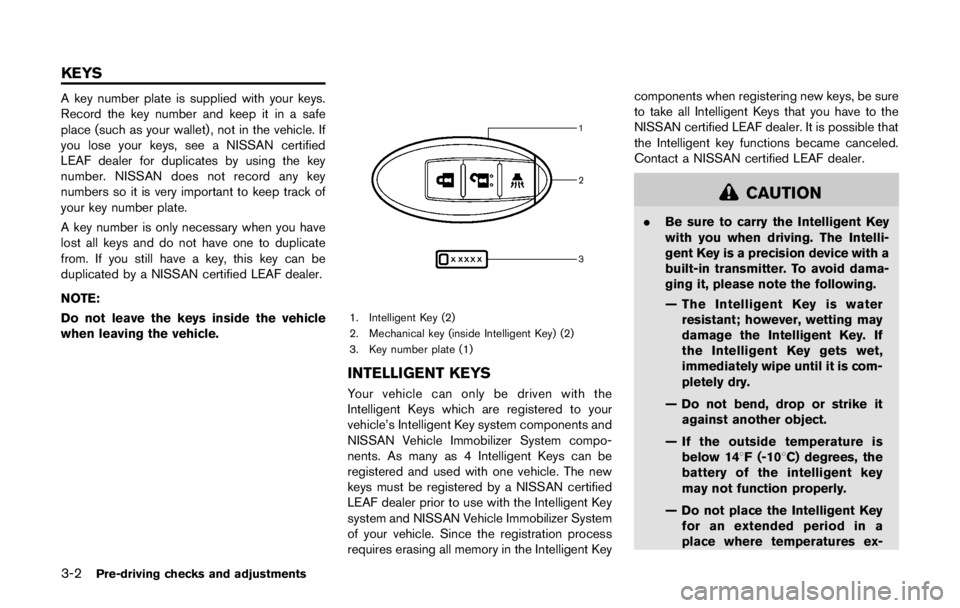
When the power switch is in the ON position,
the supplemental air bag warning light illumi-
nates for about 7 seconds and then turns off.
This means the system is operational.
If any of the following conditions occur, the front
air bag, side air bag, curtain air bag and
pretensioner systems need servicing:
.The supplemental air bag warning light
remains on after approximately 7 seconds.
. The supplemental air bag warning light
flashes intermittently.
. The supplemental air bag warning light does
not come on at all.
Under these conditions, the front air bag, side air
bag, curtain air bag and pretensioner systems
may not operate properly. They must be checked
and repaired. Take your vehicle to the nearest
NISSAN certified LEAF dealer.
Page 203 of 1062

2 Instruments and controls
Cockpit ....................................................................................... 2-3
Instrument panel ....................................................................... 2-4
Meters and gauges .................................................................. 2-5Speedometer and odometer ........................................... 2-6
Li-ion battery temperature gauge ................................... 2-7
Power meter ........................................................................ 2-7
Driving range ....................................................................... 2-8
Li-ion battery available charge gauge ........................... 2-9
Li-ion battery capacity level gauge ............................. 2-10
Outside air temperature ................................................ 2-10
ECO indicator .................................................................. 2-10
Clock .................................................................................. 2-11
Warning/indicator lights and audible reminders ........... 2-12
Checking bulbs ................................................................ 2-13
Warning lights .................................................................. 2-13
Indicator lights .................................................................. 2-18
Audible reminders ........................................................... 2-20
Dot matrix liquid crystal display ......................................... 2-22 Indicators for operation .................................................. 2-23
Trip computer ................................................................... 2-27
Warning information displays ....................................... 2-31
Indicators for maintenance ........................................... 2-33
Indicator for timer ............................................................ 2-34 Security systems .................................................................. 2-35
Vehicle security system ............................................... 2-35
NISSAN Vehicle Immobilizer System ....................... 2-36
Windshield wiper and washer switch ............................. 2-38 Washer operation ......................................................... 2-39
Rear window wiper and washer switch ........................ 2-39
Rear window and outside mirror defroster switch ...... 2-40
Instrument brightness control ............................................ 2-41
Headlight and turn signal switch ...................................... 2-41 Headlight switch ........................................................... 2-41
Turn signal switch ......................................................... 2-44
Fog light switch (if so equipped) ..................................... 2-44
Hazard warning flasher switch .......................................... 2-45
Heated steering wheel (if so equipped) ........................ 2-45
Horn ......................................................................................... 2-46
Heated seats (if so equipped) .......................................... 2-47
Vehicle Dynamic Control (VDC) OFF switch ................ 2-48
Power outlet ........................................................................... 2-49
Storage ................................................................................... 2-49 Cup holders .................................................................... 2-49
Sunglasses holder ........................................................ 2-50
Glove box ........................................................................ 2-51Console box ................................................................... 2-51
Page 220 of 1062
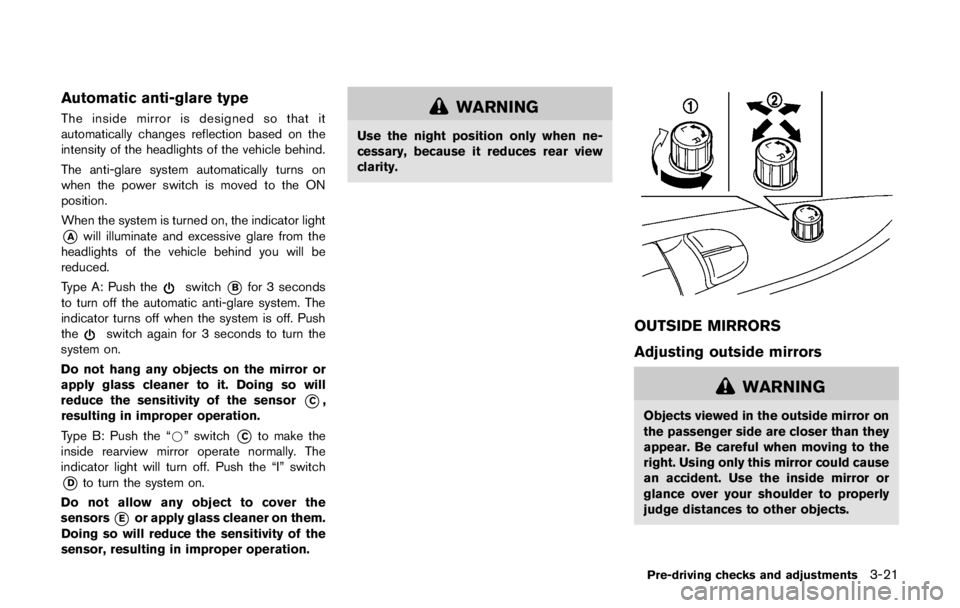
0 Illustrated table of contents
Seats, seat belts and Supplemental Restraint
System (SRS) ........................................................................... 0-2
Exterior front .............................................................................. 0-3
Exterior rear ............................................................................... 0-4
Passenger compartment ........................................................ 0-5 Cockpit ....................................................................................... 0-6
Instrument panel ...................................................................... 0-7
Meters and gauges ................................................................. 0-8
Motor compartment ................................................................ 0-9
Warning and indicator lights ............................................. 0-10
Page 229 of 1062
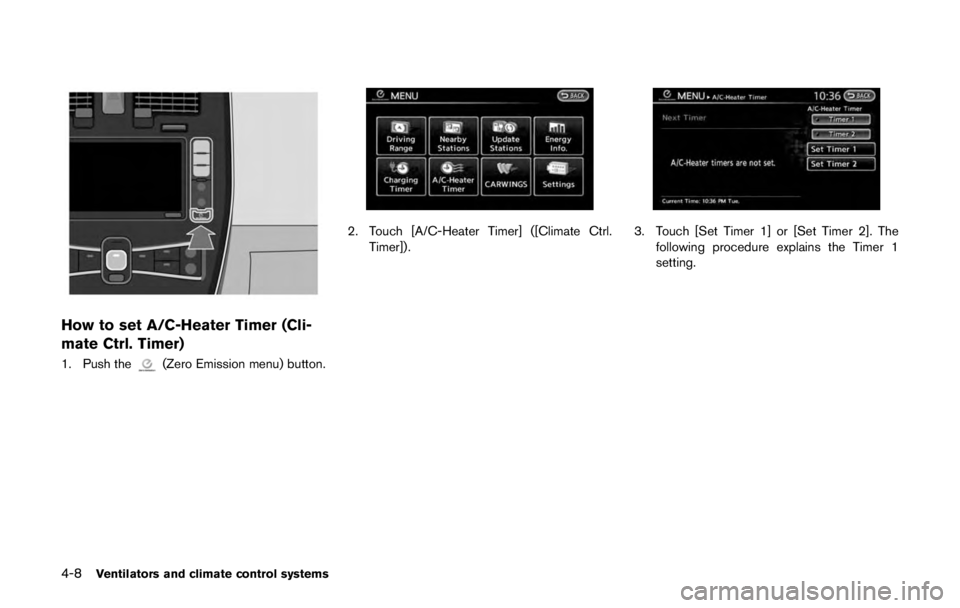
12-volt battery charge
warning light2-13
Page 238 of 1062

EMERGENCY SHUT-OFF SYSTEM
The emergency shut-off system is activated and
the high-voltage system automatically turns off in
the following conditions:
- Front and side collisions in which the air bags
are deployed.
- Certain rear collisions.
- Certain EV (Electric Vehicle) system malfunc-
tions
For the above collisions and certain other EV
(Electric Vehicle) system malfunctions, the
READY to drive indicator light will turn off. See
“Warning/indicator lights and audible remin-
ders” in the “2. Instruments and controls”
section.
The emergency shut-off activates for the above
collisions to minimize risk of an event that could
cause injury or an accident. If the emergency
shut-off system activates, the EV system may
not be switched to READY to drive position,
contact a NISSAN certified LEAF dealer. Even if
the power switch is switched to READY to drive
position, the system may shut-off suddenly.
Therefore, drive cautiously to the nearest
NISSAN certified LEAF dealer or contact a
NISSAN certified LEAF dealer as soon as
possible.WARNING
.Pay special attention to pedes-
trians. Because there is no engine
noise, pedestrians may not know
the vehicle is approaching, moving
or about to move, and may step into
the path of vehicle travel.
. When leaving the vehicle, be sure to
turn off the EV (Electric Vehicle)
system.
. Be sure to push the P (Park) posi-
tion switch on the selector lever and
apply the parking brake when park-
ing because the vehicle can move
when the READY to drive indicator
light is ON. When the READY to
drive indicator light is ON, do not
leave your vehicle in a shift position
other than the P (Park) position.
. Keep the brake pedal depressed
until you are ready to drive. When
the vehicle is in the D (drive) posi-
tion or ECO or R (reverse) position,
if you release the brake pedal and
do not depress accelerator, the
vehicle will creep and may start
abruptly. This may cause serious injury or death.
NOTE:
. The vehicle cannot run with a dis-
charged Li-ion battery. Repeated accel-
eration consumes more power from the
Li-ion battery than driving at a steady
speed.
. This vehicle is equipped with a regen-
erative brake system. The primary pur-
pose of regenerative brake system is to
provide some power to recharge the Li-
ion battery and extend driving range. A
secondary benefit is “engine braking”
that operates based on Li-ion battery
conditions.
. In the D (Drive) position, when the
accelerator pedal is released, the re-
generative brake system provides
some deceleration.
. When you put the shift selector in the
ECO position and take your foot off the
accelerator pedal, more regenerative
brake is applied than in the D (Drive)
position.
. Less deceleration is provided by the
regenerative brake system when the Li-
EV OverviewEV-9
EV (Electric Vehicle)
CHARACTERISTICS
Page 248 of 1062
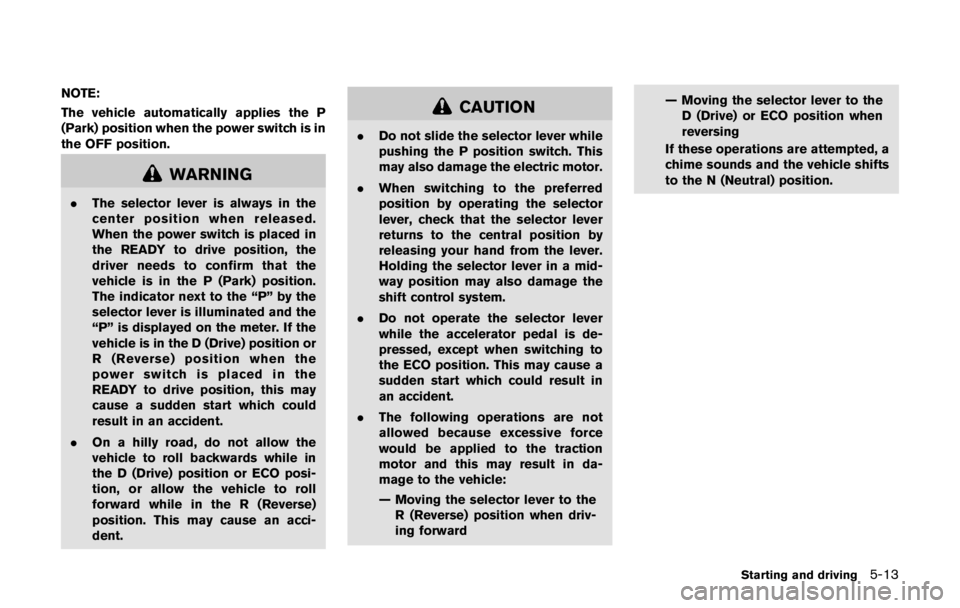
illuminates, the Li-ion battery charge is too low
for travel. See “Low battery charge warning
light” in the “2. Instruments and controls”
section. Charge the Li-ion battery as soon as
possible.
EV OverviewEV-19
Page 270 of 1062
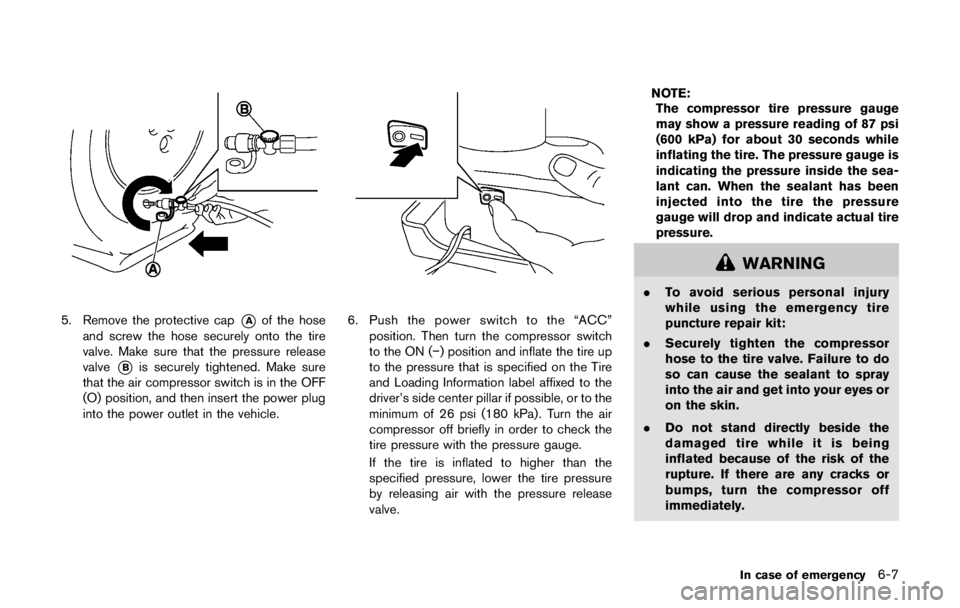
0 Illustrated table of contents
Seats, seat belts and Supplemental Restraint
System (SRS) ........................................................................... 0-2
Exterior front .............................................................................. 0-3
Exterior rear ............................................................................... 0-4
Passenger compartment ........................................................ 0-5 Cockpit ....................................................................................... 0-6
Instrument panel ...................................................................... 0-7
Meters and gauges ................................................................. 0-8
Motor compartment ................................................................ 0-9
Warning and indicator lights ............................................. 0-10